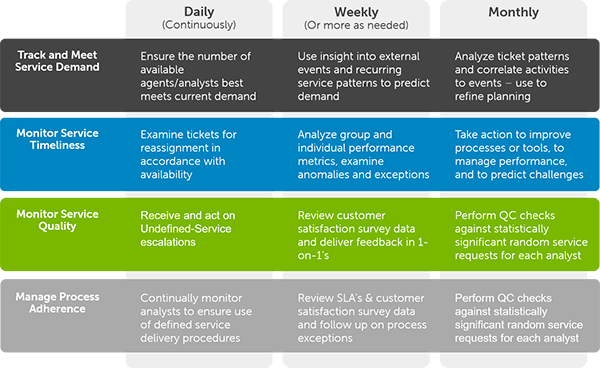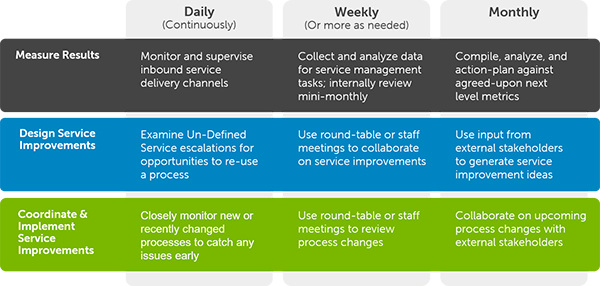Date Published - Last Updated April 19, 2019
If you agree with ITIL, successful service management is the result of “an appropriate mix of people, process, and information technology.” While ITIL is touted as a systematic approach that treats all three components equally, in practice it often focuses more heavily on the process side. However, to be successful, service managers must complement their process management skills with effective people management techniques. Only by combining people and process management will service managers will meet or exceed their service delivery objectives and build organizations that are self-directed in achieving continuous service improvements.
What Is Service Management to You?
My passion for excellence in service management stems from one of my first experiences as a director in a position where my direct reports were also people-managers. After promoting one of my best engineers/project leaders, she turned to me and said, “Now that I have people who report to me, what am I supposed to do?” For the part of her job that wasn’t project- and process-oriented, I found myself at a loss to describe the people management responsibilities of the position. It was then that I started to build a repertoire of service management practices that combined people and process management.
What does service management mean to you? How does it fit into your leadership style? Going back to ITIL, a service is defined as “a means of delivering value to customers by facilitating the outcomes customers want to achieve, but without the ownership of specific costs and risks.” The accompanying (full) definition of service management is “the implementation and management of quality IT services that meet the needs of the business. IT service management is performed by IT service providers through an appropriate mix of people, process, and information technology.” My preferred and working definition is more specific: “Service management is monitoring and optimizing the use of people, process, and tools to perform a service in a way that delivers the designed value.”
In this article, we’ll approach service management as a set of people management and process management tasks that is usually performed by supervisors and other senior leadership in a service delivery organization. Which level of management performs specific tasks depends on the nature of the task and the frequency with which the task is performed.
Linking People, Processes, and Tools
From a service management perspective, it’s crucial to consider how the different elements of the people-process-tool triad are linked to each other. When delivering services, people use processes and tools to achieve the desired outcomes. The processes themselves are supported by tools and used by people. Those tools should be designed to support the processes, and they should be easy to use. The primary linkages between these elements are system design, system training, and performance management.
The linkage between your processes and your tools is the system’s design. IT service managers enjoy a wide range of choices when it comes to ITSM tools. Most are designed to support widely accepted processes, and are customizable to meet the needs of virtually any service. For most IT service managers, the bulk of the system design work is accomplished during their ITSM tool implementation. Then the system is periodically customized to support of new or changed processes. Occasionally, an added functionality, such as a service catalog, will influence changes in the processes that support certain services.
The initial linkage between the people and the tools is the system training they receive to learn how to use the tools. It’s a good idea for service managers to have quality training materials that provide detailed instructions on the use of ITSM tools. Service managers should also have “Job Aids” and other quick reference materials that support the intended use of the ITSM tools and promote consistency. This linkage should be reinforced regularly through performance management tasks.
Performance management is the linkage between the people and the processes. Don’t limit your thinking to the annual process of setting goals, evaluating performance, and calculating compensation adjustments. As a critical component of service management, performance management should be ongoing. This includes both people and process management tasks that align with the organization’s service delivery objectives.
Service Management for Incident and Request Management
IT service delivery organizations are most often associated with the high-volume, end user-facing services that are delivered using the incident and request management processes. The incident and request management processes are largely similar, with a few important differences. There are two key junctures in the incident and request management processes. The first is the step in which the incident or request is recorded; this record is the basis for all subsequent service management activities. The second is in the classification and initiation step. During the classification step, timely and strong initial support or initiation of the request process is one of the most critical steps in achieving a positive customer experience.
It’s also very important to understand the goal of each process. Incident management seeks to return the customer to a state of normal operation and productivity, while request management seeks to deliver or release new functionality. By my working definition, the goal of a service manager should be monitoring and optimizing the use of people, process, and tools to perform these services. Three specific areas of focus correlate with these key junctures and process goals: tracking and meeting service demand, monitoring service timeliness and quality, and managing process adherence. Three additional areas of focus correlate with continuous improvement efforts: measuring results, designing service improvements, and coordinating and implementing service improvements.
Each area of focus contains people- or process-oriented service management tasks that should be performed with the frequency—daily, weekly, or monthly—that makes them most effective.
Service Management Tasks: Monitoring and Optimizing
There are three key enablers for the service manager’s people management tasks. The first enabler is being fanatical about documentation in your ITSM system’s tickets. Every action an analyst takes should be recorded in the ticketing system. Accurate and complete information is critical to the ability to manage the service and to measure and ultimately improve the service. A common refrain from the best service managers I know is, “If it isn’t in the ticket, it didn’t happen.”
The second enabler is having the skill and technology to manipulate and analyze service data, not reports. In order to efficiently and effectively use the service management system as a tool for monitoring and optimizing services, service managers must be able to “zoom in and zoom out” on meaningful data sets that accurately measure service delivery activities. The most effective tool for this is pivot tables. Almost all service delivery reports are static reports that are either too high-level to drive specific actions or intervention, or too detailed to analyze effectively. Many service management tasks depend on different views and slices of the data derived from ITSM system.
The third enabler is having regular one-on-one coaching and counseling sessions with each person who delivers services and linking their performance management measures with the service delivery data. Service managers should compare analysts in similar roles to each other, focusing on, for example, resolution times, customer satisfaction scores, and the number and type of tickets closed. These one-on-one sessions are an excellent opportunity to share an analyst’s comparative performance (i.e., individual performance against the group average) as well as both positive and negative results from any customer satisfaction surveys that are based on service tickets. In analyzing survey feedback, focus on the write-in comments, as this is where you’ll find some of the most valuable individual performance feedback. Service managers should also follow up with customers based on survey feedback, as needed. Finally, a statistically significant number of service tickets should undergo a quality control (QC) check where tickets are audited for compliance with process and documentation standards.
To integrate people and process management, service managers should demonstrate to their teams that the data in the ITSM tool is being used to measure results and drive action. Service managers that are present and approachable and take the time to monitor analysts through shadowing will create an environment where the team can embrace excellence and continuous improvement.
There are also three key enablers for the service manager’s process management tasks. The first enabler is embracing continuous improvement. It’s the nature of business that the only constant is change. Only by embracing continuous improvement can change transform from a source of chaos and confusion into a source of opportunities to optimize service delivery. Service managers should allow and encourage innovations that challenge the status quo, but only within parameters that preserve the requirements and designed goals of a given process.
The second enabler for process management is building a team of process experts and rewarding them for process improvements. All analysts should be trained to escalate undefined service delivery requests. On one of my former teams, we called it “raising the flag” because the analysts in the call center would literally raise a small orange landscaping flag to call over a supervisor and get direction on how to proceed. Training analysts to escalate undefined services encourages process adherence for defined services. Another encouragement for process adherence is using your team of process experts to change broken processes.
The third process management enabler is using a standard procedure for documenting processes. By following a standard procedure, a common format and lexicon will emerge, enabling the service manager to onboard new services quickly and streamline the service package or turnover-documentation process.
To combine and integrate people and process management, the service manager should also take action on the process improvement opportunities from each day’s and week’s service management tasks.
Service Management Tasks: Monitoring

Like the service monitoring areas of focus, the service optimizing areas of focus include tasks that are performed at different frequencies, by individuals at the supervisor level or higher. In practice, service delivery teams may find that daily service management tasks are performed at the immediate supervisor level, weekly tasks become part of a standing agenda for staff meetings and are completed by immediate supervisors and the next level of management, and monthly tasks are performed by the more senior managers. These optimizing tasks depend on the process adherence capabilities fostered by the monitoring service management tasks and the ability to embrace continuous improvement.
Service Management Tasks: Optimizing

Putting the Service Management Model to Use
The service management model described in this article is useful for outlining specific service management tasks for incident and request management, both highly transactional end user-facing processes. To put this model into practice, service delivery organizations should create a definition of service management that fits their organization’s needs and integrate their process and people management tasks with the organization’s successfully established practices. Immediate supervisors and high-level management with service management responsibilities should build a repertoire of service management tasks that suit their leadership styles and their organization’s culture. Service managers must also develop the skills to analyze data and drive action. Only then they can leverage the climate of continuous improvement that results from combining people management with process management.
Bill Payne is a results-driven IT leader and an expert in the design and delivery of cost-effective IT solutions that deliver quantifiable business benefits. His more than 30 years of experience at companies such as Pepsi-Cola, Whole Foods Market, and Dell, includes data communications consulting, messaging systems analyst, managing multiple infrastructure support and engineering teams, medical information systems deployment, retail and infrastructure systems management, organizational change management, and IT service management consulting. Leveraging his experience in leading, managing, and executing both technical and organizational transformation projects in numerous industries, Bill currently leads his own service management consulting company. Find him on
LinkedIn, and follow him on Twitter
@ITSMConsultant.